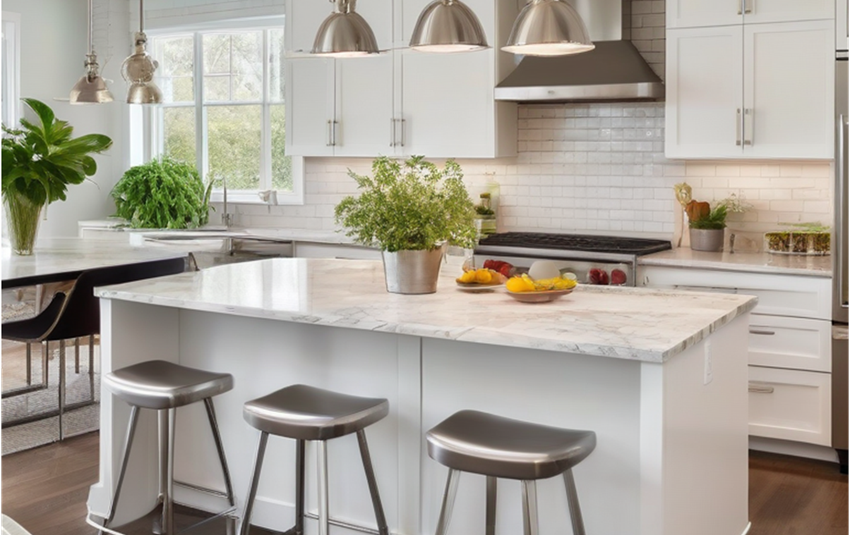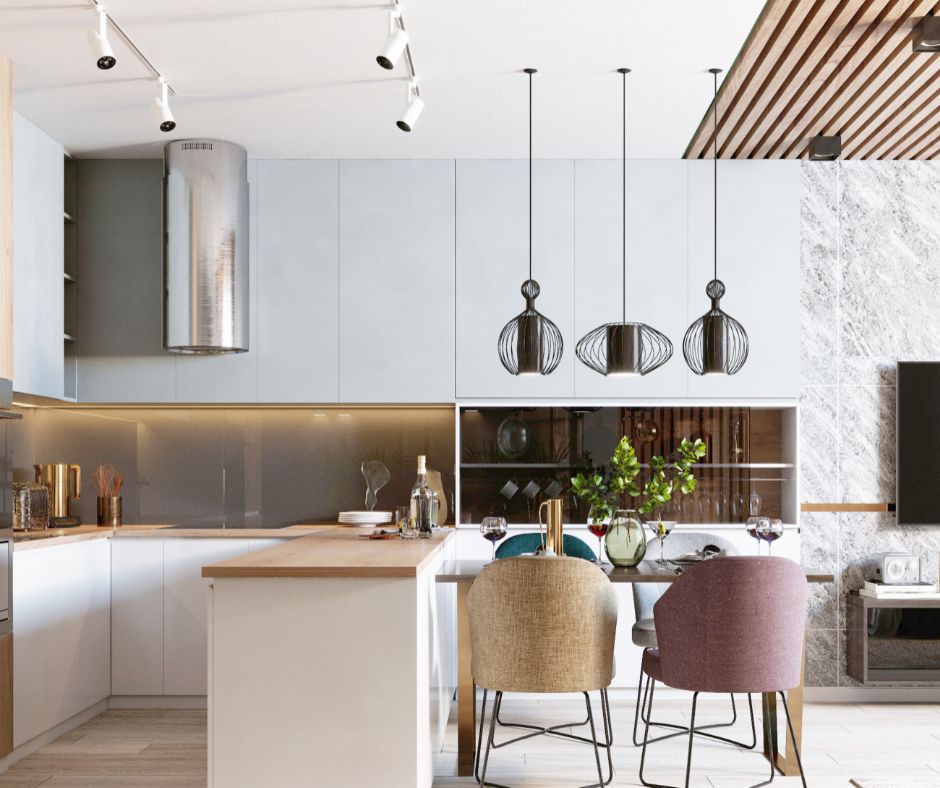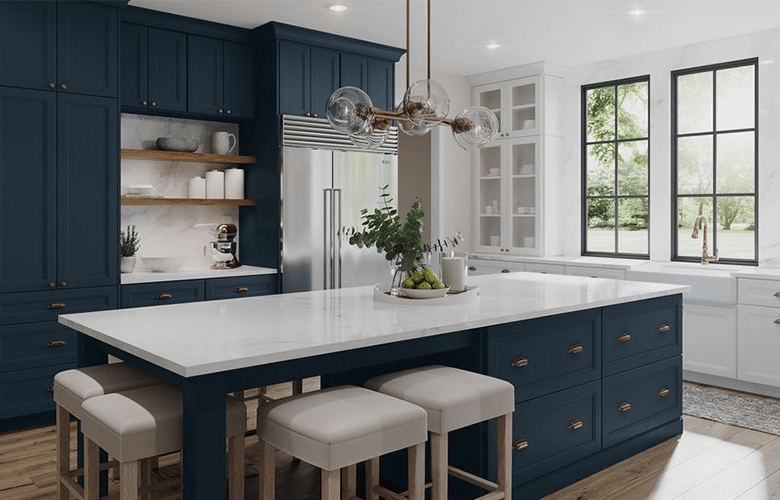Top 10 Kitchen Renovation FAQs Answered
The kitchen is often considered the heart of the home, and it’s no wonder that it’s at the top of the home renovation wish list for many homeowners. Whether you have a large or small kitchen, there’s always the desire for more storage space, updated fixtures, and a fresh look. The good news is that even with a small budget, you can give your kitchen a beautiful update and improve its functionality.
Simple and inexpensive DIY changes can make a big impact on your kitchen. For example, painting your cabinets a fresh color, replacing the hardware, and updating the lighting fixtures can instantly transform the space. If you have a little more in your budget, you can consider replacing just the cabinet doors for a more classic look or removing bulky upper cabinets and installing open shelving for a contemporary feel. If you’re ready for a full renovation, consulting an architect or kitchen designer can help you make the most of your space and create a kitchen that meets your needs and style preferences.
In this blog, we will address some of the frequently asked questions about kitchen renovations, such as what to consider before starting a renovation, how to maximize space in a small kitchen, the latest trends in kitchen design, how to choose the right materials for your countertops, lighting options, the choice between open shelving and cabinets, selecting the perfect kitchen appliances, flooring options, budgeting for a renovation, and the do’s and don’ts of kitchen renovation.
Understanding Kitchen Layouts and Their Functions
Kitchen design and layout play a crucial role in the functionality and aesthetics of your kitchen. A well-designed kitchen layout can make cooking and meal preparation more efficient and enjoyable. Key elements to consider in your kitchen layout include the placement of the kitchen island, the prep area, and the cabinetry. A kitchen island can provide additional workspace and storage, while a well-designed prep area can make cooking tasks easier. Cabinetry should be strategically placed to maximize storage and accessibility.
Here are the top 10 FAQs we answered:
1. What Should You Consider Before Starting a Kitchen Renovation?
Before starting a kitchen renovation, it’s important to consider several factors. First, determine your budget and identify what areas of the kitchen you want to prioritize. Next, gather design ideas that align with your style preferences. Finally, hire a reputable general contractor who can guide you through the renovation process and ensure that your vision becomes a reality.
2. How Can You Maximize Space in a Small Kitchen?
Maximizing space in a small kitchen requires careful planning and smart storage solutions. Consider incorporating open shelves instead of traditional cabinets to create a sense of openness and accessibility. Removing cabinet doors can also give the kitchen a contemporary feel. Utilize every available inch by installing storage solutions such as pull-out drawers and organizers.
3. What Are the Latest Trends in Kitchen Design?
The latest trends in kitchen design include stainless steel appliances, subway tiles for a timeless look, and pendant lights for added style and functionality. These design elements are popular in modern homes and create a clean and contemporary look. Incorporating these trends can give your kitchen a fresh and updated feel.
4. How to Choose the Right Materials for Your Kitchen Countertops?
When choosing materials for your kitchen countertops, consider factors such as durability, maintenance, and style. Options like quartz and granite are popular choices due to their durability and resistance to stains and scratches. Consulting with an interior designer can help you select the right material that suits your needs and design preferences.
5. What Lighting Options Will Enhance Your Kitchen’s Aesthetics?
The right lighting can enhance the aesthetics of your kitchen and create a sophisticated ambiance. Pendant lights, for example, provide both functional lighting and a stylish focal point. Consider incorporating different types of lighting fixtures to create layers of light and set the desired mood. Lighting can also be used to highlight specific areas or decor elements in your kitchen.
6. Should You Choose Open Shelving or Cabinets?
The choice between open shelving and cabinets depends on your preferences and the functionality you desire in your kitchen. Open shelves can create a sense of openness and accessibility, making it easier to grab frequently used items. Cabinets, on the other hand, provide concealed storage and can create a more streamlined and organized look. Consider your storage needs and the overall design aesthetic when deciding between open shelving and cabinets.
7. How to Select the Perfect Kitchen Appliances?
Selecting the perfect kitchen appliances involves considering factors such as style, functionality, and energy efficiency. Stainless steel appliances are a popular choice due to their durability and sleek appearance. When choosing appliances, consider your cooking habits and the features that are important to you. For example, a dishwasher can save time and effort in cleaning up after meals. Energy-efficient appliances are also worth considering as they can help reduce energy consumption and lower utility bills. Here is a comparison of different kitchen appliances:
| Appliance | Description |
| Dishwasher | A time-saving appliance that automates the dishwashing process. |
| Range/Oven | Provides a cooking surface and oven for baking and roasting. |
| Refrigerator | Keeps food fresh and provides storage for perishable items. |
| Microwave | Heats food quickly and efficiently. |
| Ventilation Hood | Removes cooking odors and smoke from the kitchen. |
By carefully selecting kitchen appliances that meet your needs and preferences, you can create a functional and efficient kitchen space.
8. What Flooring Options Are Best Suited for Kitchens?
Choosing the right flooring for your kitchen is important as it needs to be durable, easy to clean, and visually appealing. Here are some flooring options that are best suited for kitchens:
- Vinyl flooring: Vinyl is a popular choice for kitchen floors due to its durability, water resistance, and low maintenance requirements. It is available in a variety of styles and can mimic the look of other flooring materials such as hardwood or tile.
- Tile flooring: Tile is another great option for kitchen floors as it is durable and easy to clean. It comes in a wide range of colors and patterns, allowing you to create a customized look for your kitchen.
- Hardwood flooring: Hardwood floors add warmth and beauty to any kitchen design. However, they require more maintenance and may not be as water-resistant as other flooring options. Consider using engineered hardwood for better moisture resistance.
When choosing flooring for your kitchen, consider your lifestyle, design preferences, and maintenance requirements to ensure you select the right option for your needs.
9. How to Budget for Your Kitchen Renovation?
Budgeting for a kitchen renovation is essential to ensure that you can achieve your desired results without overspending. Here are some tips to help you budget for your kitchen renovation:
- Determine your budget: Start by setting a realistic budget for your renovation. Consider factors such as the cost of materials, labor, and any additional expenses such as permits or hiring a general contractor.
- Prioritize your expenses: Identify the key areas of your kitchen that you want to focus on during the renovation. This will help you allocate your budget accordingly and ensure that you invest in the areas that are most important to you.
- Research costs: Research the average costs of materials and labor in your area. This will give you a better understanding of what to expect and help you avoid any surprises during the renovation process.
- Shop around for deals: Look for sales or discounts on materials and appliances. Consider shopping at home improvement stores like Home Depot or exploring online options to find the best deals.
- Consider the resale value: When making decisions about your renovation, consider how it will impact the resale value of your home. Focus on upgrades that will provide a good return on investment and appeal to potential buyers.
By following these budgeting tips, you can ensure that your kitchen renovation stays within your financial means while still achieving your desired results.
10. What Are the Do’s and Don’ts of Kitchen Renovation?
Kitchen renovations can be exciting but also overwhelming. To ensure a successful renovation, here are some do’s and don’ts to keep in mind:
Do’s:
- Do plan and research thoroughly before starting your kitchen renovation.
- Do consider the layout and flow of your kitchen to optimize functionality.
- Choose a paint color that complements your design aesthetic and creates a cohesive look.
- Do hire professionals for plumbing, framing, and drywall work to ensure quality and safety.
- Do focus on elements that have a big impact, such as countertops, backsplash, and lighting.
Don’ts:
- Don’t rush the planning process. Take the time to consider your needs and design preferences.
- Don’t overlook the importance of proper plumbing and electrical work. Hire licensed professionals for these tasks.
- Don’t forget about storage. Plan for ample storage space to keep your kitchen organized.
- Don’t skimp on quality materials. Invest in durable and long-lasting products that will withstand daily use.
- Don’t neglect the details. Pay attention to small elements like hardware, lighting fixtures, and paint finishes to create a polished and cohesive look.
By following these do’s and don’ts, you can ensure a successful kitchen renovation that meets your needs and brings your design vision to life.
Conclusion
If you’re looking to transform your kitchen, understanding the layout and functionalities is key. From maximizing space to selecting trendy designs and materials, this FAQ guide covers it all. Remember, thoughtful planning and budgeting are essential for a successful renovation. Whether you opt for open shelving or cabinets, the right choice can enhance both aesthetics and functionality. To bring your dream kitchen to life, consider the latest lighting options and top-notch appliances. Ready to embark on this exciting journey? Get in touch with us, and let’s create the kitchen of your dreams together!




